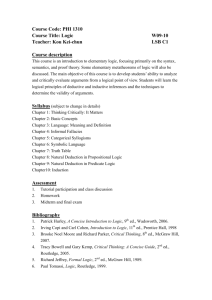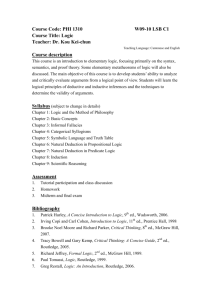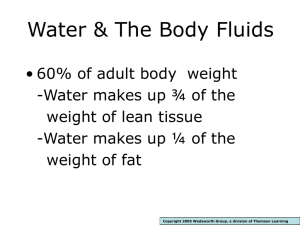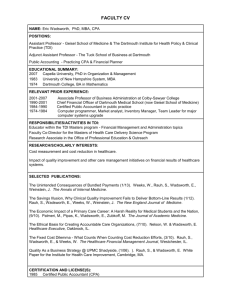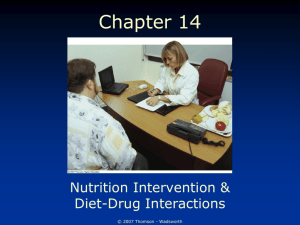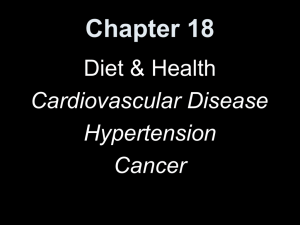Chpt 10 - Nutrition and Pregnancy/Infancy
advertisement
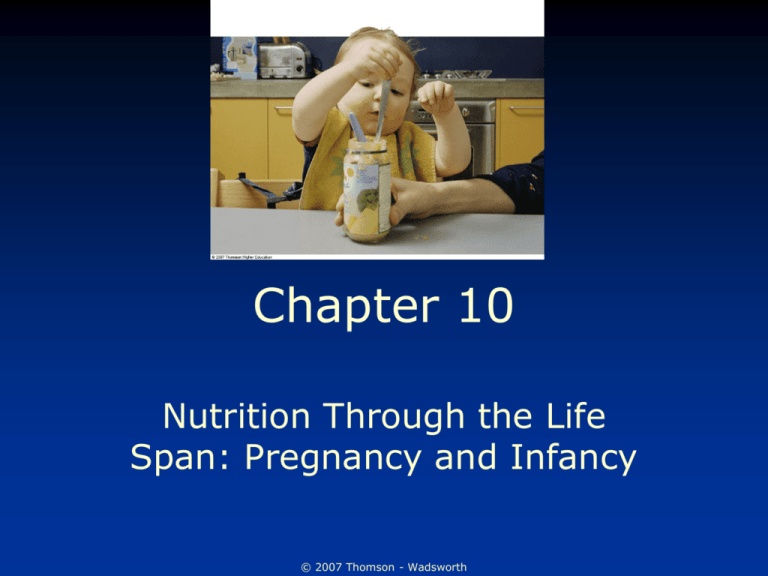
Chapter 10 Nutrition Through the Life Span: Pregnancy and Infancy © 2007 Thomson - Wadsworth Nutrition Prior to Pregnancy • Achieve & maintain a healthy body weight • Choose an adequate & balanced diet • Be physically active • Avoid harmful substances © 2007 Thomson - Wadsworth Prepregnancy Weight • Underweight or overweight before pregnancy presents medical risks © 2007 Thomson - Wadsworth Underweight • High risk of having a lowbirthweight baby • Low-birthweight More risk for disease 40 times more likely to die in first month • Long-term effects Risk for obesity & hypertension later in life Lower adult IQ Short stature Educational disadvantages © 2007 Thomson - Wadsworth Causes of Low-Birthweight • Mother’s Poor nutrition Heredity Disease conditions Smoking Drug & alcohol use © 2007 Thomson - Wadsworth Overweight & Obesity • Babies • Mom Are larger Twice as likely to have neural tube deficits Greater risk of heart defects More likely to need labor induced May need C-section More post-partum hypertension, infections, & gestational diabetes © 2007 Thomson - Wadsworth Healthy Support Tissues • Prepregnancy nutrition needed to support growth of a healthy placenta • Placenta Supply depot Waste-removal system • Umbilical cord Pipeline from placenta to fetus • Amniotic sac Surrounds baby Cushions it with fluids © 2007 Thomson - Wadsworth The Events of Pregnancy • Newly fertilized ovum called a zygote • Implants in uterine wall in 2 weeks • Placenta begins to grow • Crucial time period • Adverse influences can lead to Failure to implant Neural tube deficits • Smoking • Drug abuse • Malnutrition © 2007 Thomson - Wadsworth The Embryo & Fetus • Embryo develops into a fetus • At 8 weeks fetus has Complete CNS Beating heart Fully formed digestive tract Well-defined fingers & toes Beginning facial features • Last 7 months Grows 50 times heavier & 20 times longer • Pregnancy 39-41 weeks duration • Infant Weight 6 ½ - 9 pounds © 2007 Thomson - Wadsworth © 2007 Thomson - Wadsworth Critical Periods • Development of each organ takes place at a certain time (critical period) • Effects of malnutrition at a critical period are irreversible © 2007 Thomson - Wadsworth Effects of Malnutrition • Nervous system defects of the embryo • Child’s poor dental health • Adolescent’s & adult’s vulnerability to infection • Higher risk of diabetes, hypertension, stroke, or heart disease © 2007 Thomson - Wadsworth © 2007 Thomson - Wadsworth Nutrient Needs During Pregnancy • Some increase • Must make careful choices • Woman’s body Maximizes absorption Minimizes losses © 2007 Thomson - Wadsworth Nutrient Needs • Energy (kcalories) Additional 340 in 2nd trimester Additional 450 in 3rd trimester Select nutrient-dense foods • Carbohydrates Additional 175 g Fiber for constipation • Protein Additional 25 g Protein supplements are discouraged • Fats Little room for oil, margarine, & butter Need essential fatty acids © 2007 Thomson - Wadsworth Special Interest • Folate Role in cell reproduction Increased from 400600 mcg/day Prevents neural tube deficits • Spina bifida • Anencephaly • Vitamin B12 Needed to assist folate in manufacture of new cells Found in animal products Vegans need fortified foods or supplements Supplements, fortified foods or both © 2007 Thomson - Wadsworth © 2007 Thomson - Wadsworth Nutrients for Bones • Vitamin D, calcium, phosphorus, magnesium • Intestinal absorption of calcium doubles early in pregnancy • Final weeks, more than 300 mg transferred to fetus • Increase milk products • May need supplements • Calcium-fortified soy milk & orange juice © 2007 Thomson - Wadsworth Fluoride • Mineralization of teeth begins in 5th month • Fluoride supplements Recommended if do not have fluoridated water Not recommended if have fluoridated water © 2007 Thomson - Wadsworth Iron • Absorption of iron increases threefold • Fetus draws heavily on mother’s stores • Daily supplement 30 mg iron 2nd & 3rd trimester • Iron-rich food Liver, oysters Meat, fish Dried fruits Legumes Dark green vegetables • Vitamin C-rich foods enhance absorption © 2007 Thomson - Wadsworth Zinc • Needed for DNA, RNA & protein synthesis • Deficiency predicts low birthweight • Found in foods of high protein content • Iron interferes with zinc absorption • May need zinc supplements © 2007 Thomson - Wadsworth Nutrient Supplements • Prenatal supplements provide more • Needed for Those with poor diet High-risk pregnancies Multiple fetuses Cigarette smokers Alcohol & drug abusers Folate Iron Calcium • Reduce risks of Preterm delivery Low birthweight Birth defects © 2007 Thomson - Wadsworth Food Assistance Programs • Women, Infants, Children (WIC) Vouchers for nutritious food Food education Iron-fortified formula • Federal Food Stamps • Nutrition education American Dietetic Association American Diabetes Association Local hospitals © 2007 Thomson - Wadsworth Weight Gain • Essential for healthy pregnancy • Normal-weight woman 3 ½ pounds first trimester 1 pound/week thereafter © 2007 Thomson - Wadsworth Physical Activity • Very important Improves her fitness Facilitates labor Helps to prevent or manage gestational diabetes Reduces psychological stress • Low-impact activities • Avoid Activities with potential for falls or being hit by others Saunas Steam rooms Whirlpools © 2007 Thomson - Wadsworth Common Nutrition-Related Concerns • Food sensitivities • Nausea • Heartburn • Constipation © 2007 Thomson - Wadsworth Food Cravings & Aversions • Cravings Do not seem to reflect physiological needs • Cravings & aversions Probably due to © 2007 Thomson - Wadsworth • Hormone-induced changes in taste • Sensitivities to smells Nonfood Cravings • Pica Craving items such as laundry starch, clay, soil, or ice. Common among African American women Often associated with iron deficiency © 2007 Thomson - Wadsworth Other Concerns • Morning Sickness Comes from hormonal changes in early pregnancy Mild queasiness to debilitating nausea Smells often trigger it • Heartburn Fetus puts pressure on woman’s stomach Acid may back up • Constipation High-fiber diet Physical activity Plentiful fluids © 2007 Thomson - Wadsworth Problems in Pregnancy • Gestational Diabetes • Hypertension Pre-existing Usually resolves after the birth Often leads to surgical birth & high infant birthweight • Risk of low-birthweight infant • Separation of placenta Transient © 2007 Thomson - Wadsworth • Usually resolves after the birth Preeclampsia • Symptoms Hypertension Protein in the urine Whole body edema • Usually first pregnancy • After 20 weeks • May experience convulsions Eclampsia Need prompt medical attention © 2007 Thomson - Wadsworth Avoid Cigarette Smoking • Behavioral or • Nicotine & cyanide intellectual problems are toxic to a fetus later in life • Second-hand smoke • Implicated in SIDS is also problematic (sudden infant death • Blood flow is syndrome) restricted • More complicated • Slows fetal growth births • Low birthweight © 2007 Thomson - Wadsworth Avoid • Medicinal drugs • Drugs of abuse No over-the-counter No medicines not prescribed No aspirin or ibuprofen in last 3 months • Herbal supplements Almost none have been tested for safety during pregnancy Cross the placenta Impair growth & development • Environmental contaminants Lead & mercury Avoid certain types of fish © 2007 Thomson - Wadsworth Avoid • Foodborne illness • Dieting Listeriosis • Can cause miscarriage, stillbirth • Severe brain injury, other infections to fetus & newborn • Vitamin-mineral megadoses Hazardous during pregnancy • Sugar substitutes Use in moderation • Caffeine Limit to one cup coffee or two 12-oz colas Many are toxic in excess Need care with vitamin A © 2007 Thomson - Wadsworth Alcohol • Fetal alcohol syndrome (FAS) Irreversible brain damage Mental retardation Facial abnormalities Vision abnormalities • No amount is safe © 2007 Thomson - Wadsworth Adolescent Pregnancy • Intense nutrient needs • Often deficient before pregnancy • Encouraged to gain about 35 pounds • Risks for Low-birthweight Miscarriage Stillbirth Death of infant in first year © 2007 Thomson - Wadsworth Breastfeeding • Recommendation Exclusive breastfeeding for 6 months Then breastfeeding with complementary foods through 12 months © 2007 Thomson - Wadsworth Nutrition During Lactation • Eat nutrientdense foods • Enjoy ample food & fluids at frequent intervals © 2007 Thomson - Wadsworth Nutrition Needs • Energy • Vitamins & minerals An extra 330 kcalories/day • Weight loss 1 pound/week • Water Need about 13 cups/day Milk quality is maintained at expense of maternal stores Undernourished may need supplements • Particular foods Some might bother baby © 2007 Thomson - Wadsworth Contraindications to Breastfeeding • • • • • • Alcohol Caffeine Cigarette smoke Medications Illicit drugs Some maternal illnesses • May reduce milk production • May enter breast milk & impair infant development © 2007 Thomson - Wadsworth Nutrition of the Infant • Affects later development • Sets the stage for eating habits • Provide a nurturing, relaxing environment © 2007 Thomson - Wadsworth Nutrients to Support Growth • Weight doubles by 4-5 months • Triples by 1 year • BMR is very high • Need 100 kcalories/kg Adequate vitamin A, D, & calcium Adequate water Dose of vitamin K at birth © 2007 Thomson - Wadsworth Breast Milk • Energy nutrients Carbohydrates • Lactose • Enhances calcium absorption • Vitamins & Minerals Vitamin D supplement needed • If breastfed • If not on vitamin Dfortified formula Lipids • Generous amount of essential fatty acids Protein • Alpha-lactalbumin • Easily digestible • Lower in sodium • Highly absorbable iron & zinc © 2007 Thomson - Wadsworth © 2007 Thomson - Wadsworth Supplements for Infants • After 6 months may need Vitamin D Iron Fluoride © 2007 Thomson - Wadsworth Benefits of Breast Milk • Immunological protection • Infant has less Colostrum (premilk substance) Maternal immune factors Enzymes that offer protection Stomach & intestinal disorders Middle ear infections Respiratory illness © 2007 Thomson - Wadsworth Other Potential Benefits • May protect Against adult obesity Cardiovascular disease • May have a positive effect On later intelligence © 2007 Thomson - Wadsworth Infant Formula • Can offer the same Closeness Warmth Stimulation © 2007 Thomson - Wadsworth Formula Composition • • • • Similar to breast milk Offers no immunity Standards have been set All need to be iron fortified • Are special formulas for allergies & lactose intolerance • Risks of over-dilution & contamination © 2007 Thomson - Wadsworth Nursing Bottle Tooth Decay • Do not put infant to bed with a bottle • Can cause Dental caries Bucktoothed profile © 2007 Thomson - Wadsworth Transition to Cow’s Milk • Not appropriate in first year • 1-2 years need whole milk • 2-5 years can transition to lower fat • Cow’s milk Is a poor source of iron Higher in calcium but lower in vitamin C (inhibits iron absorption) Higher protein can stress infant’s kidneys © 2007 Thomson - Wadsworth Introducing First Foods • First foods can be introduced between 4-6 months • Can sit with support & control head movements © 2007 Thomson - Wadsworth Foods to Provide Iron & Vitamin C • Breast milk & ironfortified formula • Iron-fortified cereals • Meat & meat alternatives • Fruits & vegetables for vitamin C © 2007 Thomson - Wadsworth Physical Readiness • 4-6 months can swallow solids • 8-12 months Can handle finger foods Begins to teethe Hard crackers can be introduced © 2007 Thomson - Wadsworth Infant Feeding • Allergy-causing foods Introduce foods one at a time Rice cereal first Wheat last • Choice of foods Baby foods Blenderized table food • Foods to omit Sweets of any kind No canned vegetables • High in sodium Honey • Risk of botulism Foods that cause risk for choking • Foods at 1 year Same foods as rest of family © 2007 Thomson - Wadsworth Looking Ahead • Introduce a • Avoid food as variety of A reward nutritious foods Comfort for unhappiness • Don’t force to Deprivation for finish food & drink punishment © 2007 Thomson - Wadsworth Feeding Guidelines for Mealtime • Discourage unacceptable behavior • Let the child explore & enjoy food • Don’t force food on children • Strictly limit sweets © 2007 Thomson - Wadsworth
